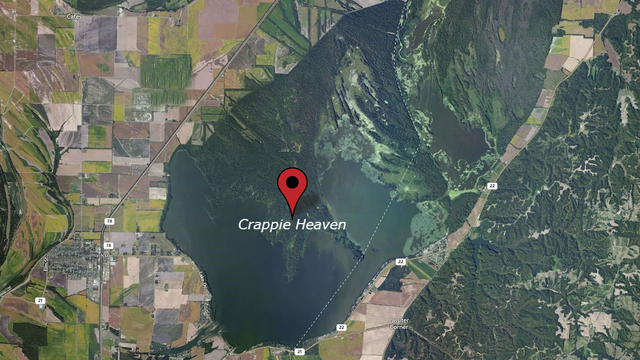
The Top 7 Giant Crappie Lakes
At small sizes, crappies are just another panfish; frisky, fun to catch, and mighty fine when rolled in flour and given a grease bath. At around 13 or 14 inches though, crappies transform from “just another panfish” into what serious speck chasers call a “slab.” Slabs have different habits, tend to feed on different forage, and cause serious cases of fish-itis in even the saltiest pan fishermen.Countless lakes across the country contain healthy populations of crappie, but to produce consistent enough catches of slab crappies to be considered a crappie lake, a waterbody needs to be special. It has to have an exact perfect combination of fertility, cover, and abundant forage, along with anglers willing to let a few grow.These 7 lakes have that combination in spades, so if you’re looking to catch a wall hanger crappie, it’d probably be a good idea to plan a visit these Giant Crappie Lakes:
1. Grenada Lake, Mississippi
Realistically, any of the three major flood control reservoirs along I-55 in Mississippi (Grenada, Sardis, and Arkabutla) could have been included on our crappie lakes list. They are ground zero for giant slabs, and one of the few places where specs are the primary quarry for most anglers. Right now, Grenada is the hottest of the three – which has it living up to its billing as “The King Of The 3 Pound Crappie” Best bets are trolling the channel edges and throwing bigger bass-sized crankbaits around flooded timber.
2. Reelfoot Lake, Tennessee
Located right on top of the New Madrid fault line, Reelfoot lake was formed in 1811 and 1812 after a series of powerful earthquakes shook the region and caused a subsidence that over time flooded 13,000 acres of marshland. With an average depth of only 5 feet, almost all of Reelfoot’s 13,000 acres is chock full of timber, stumps, and vegetation – giving crappie a smorgasbord of cover and forage. Try drifting while spider-rigging tubes 3 feet down over the 6 foot stump flats.
3. Lake of the Woods, Ontario
Many serious slab chasers believe the south is the only place to catch large stringers of giant specs. Unfortunately, they’d be wrong. One of the hottest spots in the world to hook into a trophy crappie is Lake of the Woods, the massive lake system that straddles the Minnesota/Ontario border. With 65,000 miles of shoreline and over 14,500 islands, there is more excellent crappie habitat in Lake of the Woods than an angler could fish in a lifetime. Because are fairly common. Lake of the Woods is also one of the best places in the world to catch a trophy slab through the ice.
4. Shelbyville Lake, Illinois
This 11,000 acre reservoir is the closest thing to heaven for slab crappie chasers in the Midwest. An impoundment of the Kaskaskia River, Shelbyville contains an abundance of sunken brush, river channel ledges, and offshore structure that huge crappie relate to. If it’s a wall hanger you’re looking for, try targeting suspended fish by trolling bigger cranks 10 – 14 feet down around points, creek channels, and over brush.
5. Toledo Bend Reservoir, Louisiana
At 185,000 acres, Toledo Bend is the fifth largest man-made body of water in the country, and it’s already at the top of many anglers’ lists as a largemouth bass destination. As good as the bass fishing is though; it’s probably an even better crappie lake. With miles of flooded timber, fertile water, and ample baitfish; Toledo Bend crappies grow fast and mean. A recent study showed that crappie in Toledo Bend only need 4 years to reach 12 inches. Best bets for a giant include pitching jigs to standing timber and fishing a minnow on a slip bobber over deep brush.
6. Santee-Cooper, South Carolina
Probably one of the most unique crappie lakes on this list, Santee-Cooper reservoir consists of twin lakes Marion and Moultrie – referred to as South Carolina’s “inland sea.” With over 177,000 acres of flooded Cyprus, backwater ponds, and former agricultural fields, there aren’t many more fertile reservoirs in the country. 10-12 inch crappie are commonplace, and fish up to 16 inches regularly come boat side to anglers pitching minnows or plastics to stumps, cypress knees, and brush piles.
7. Weiss Lake, Alabama
Although the Coosa River is known more for spotted bass, the reservoirs along its length are also prolific crappie fisheries. Chief among them is Alabama’s Weiss Lake, which is known by many as the “Crappie Capital of the World.” Although Weiss has experienced a couple down years in productivity, it’s still kicking out 2 and 3 pound fish to anglers longlining crankbaits or live bait along channel bends and points.Where have you had luck catching some giant crappie? Let us know in the comments!
Updated September 28th, 2020 at 9:52 AM CT
